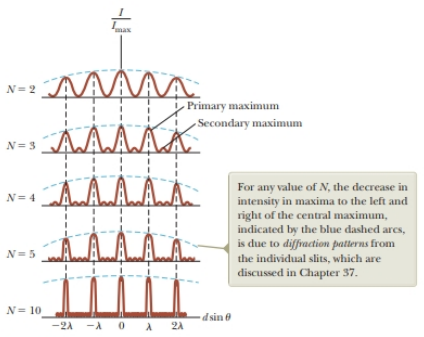
Bundle: Physics for Scientists and Engineers with Modern Physics, Loose-leaf Version, 10th + WebAssign Printed Access Card for Serway/Jewett's Physics for Scientists and Engineers, 10th, Multi-Term
10th Edition
ISBN: 9781337888592
Author: Raymond A. Serway, John W. Jewett
Publisher: Cengage Learning
expand_more
expand_more
format_list_bulleted
Concept explainers
Textbook Question
Chapter 36.3, Problem 36.2QQ
Using Figure 36.6 as a model, sketch the interference pattern from six slits.

Figure 36.6 Multiple-slit interference patterns. As N, the number of slits, is increased, the primary maxima (the tallest peaks in each graph) become narrower but remain fixed in position and the number of secondary maxima increases.
Expert Solution & Answer
Trending nowThis is a popular solution!

Students have asked these similar questions
Discuss the differences between the Biot-Savart law and Coulomb’s law in terms of their applicationsand the physical quantities they describe.
Explain why Ampere’s law can be used to find the magnetic field inside a solenoid but not outside.
3. An Atwood machine consists of two masses, mA
and m B, which are connected by an inelastic cord
of negligible mass that passes over a pulley. If the
pulley has radius RO and
moment of inertia I about its axle, determine the
acceleration of the masses
mA and m B, and compare to the situation where the
moment of inertia of the
pulley is ignored. Ignore friction at the axle O. Use
angular momentum and torque in this solution
Chapter 36 Solutions
Bundle: Physics for Scientists and Engineers with Modern Physics, Loose-leaf Version, 10th + WebAssign Printed Access Card for Serway/Jewett's Physics for Scientists and Engineers, 10th, Multi-Term
Ch. 36.2 - Which of the following causes the fringes in a...Ch. 36.3 - Using Figure 36.6 as a model, sketch the...Ch. 36.5 - One microscope slide is placed on top of another...Ch. 36 - Two slits are separated by 0.320 mm. A beam of...Ch. 36 - Why is the following situation impossible? Two...Ch. 36 - A laser beam is incident on two slits with a...Ch. 36 - In a Youngs double-slit experiment, two parallel...Ch. 36 - Light of wavelength 620 nm falls on a double slit,...Ch. 36 - Light with wavelength 442 nm passes through a...Ch. 36 - A student holds a laser that emits light of...
Ch. 36 - A student holds a laser that emits light of...Ch. 36 - Coherent light rays of wavelength strike a pair...Ch. 36 - In Figure P36.10 (not to scale), let L = 1.20 m...Ch. 36 - You are working in an optical research laboratory....Ch. 36 - You are operating a new radio telescope that has...Ch. 36 - In the double-slit arrangement of Figure P36.13, d...Ch. 36 - Monochromatic light of wavelength is incident on...Ch. 36 - Prob. 15PCh. 36 - Show that the distribution of intensity in a...Ch. 36 - Green light ( = 546 nm) illuminates a pair of...Ch. 36 - Monochromatic coherent light of amplitude E0 and...Ch. 36 - A material having an index of refraction of 1.30...Ch. 36 - A soap bubble (n = 1.33) floating in air has the...Ch. 36 - A film of MgF2 (n = 1.38) having thickness 1.00 ...Ch. 36 - An oil film (n = 1.45) floating on water is...Ch. 36 - When a liquid is introduced into the air space...Ch. 36 - You are working as an expert witness for an...Ch. 36 - Astronomers observe the chromosphere of the Sun...Ch. 36 - A lens made of glass (ng = 1.52) is coated with a...Ch. 36 - Mirror M1 in Figure 36.13 is moved through a...Ch. 36 - Radio transmitter A operating at 60.0 MHz is 10.0...Ch. 36 - In an experiment similar to that of Example 36.1,...Ch. 36 - In the What If? section of Example 36.2, it was...Ch. 36 - Two coherent waves, coming from sources at...Ch. 36 - Raise your hand and hold it flat. Think of the...Ch. 36 - In a Youngs double-slit experiment using light of...Ch. 36 - Review. A flat piece of glass is held stationary...Ch. 36 - Figure P36.35 shows a radio-wave transmitter and a...Ch. 36 - Figure P36.35 shows a radio-wave transmitter and a...Ch. 36 - In a Newtons-rings experiment, a plano-convex...Ch. 36 - Measurements are made of the intensity...Ch. 36 - A plano-concave lens having index of refraction...Ch. 36 - Why is the following situation impossible? A piece...Ch. 36 - Interference fringes are produced using Lloyds...Ch. 36 - A plano-convex lens has index of refraction n. The...Ch. 36 - Prob. 43APCh. 36 - Prob. 44APCh. 36 - Astronomers observe a 60.0-MHz radio source both...Ch. 36 - Prob. 46CPCh. 36 - Our discussion of the techniques for determining...Ch. 36 - The condition for constructive interference by...Ch. 36 - Both sides of a uniform film that has index of...Ch. 36 - Slit 1 of a double-slit is wider than slit 2 so...
Knowledge Booster
Learn more about
Need a deep-dive on the concept behind this application? Look no further. Learn more about this topic, physics and related others by exploring similar questions and additional content below.Similar questions
- A 0.850-m-long metal bar is pulled to the right at a steady 5.0 m/s perpendicular to a uniform, 0.650-T magnetic field. The bar rides on parallel metal rails connected through a 25-Ω, resistor (Figure 1), so the apparatus makes a complete circuit. Ignore the resistance of the bar and the rails. Please explain how to find the direction of the induced current.arrow_forwardFor each of the actions depicted, determine the direction (right, left, or zero) of the current induced to flow through the resistor in the circuit containing the secondary coil. The coils are wrapped around a plastic core. Immediately after the switch is closed, as shown in the figure, (Figure 1) in which direction does the current flow through the resistor? If the switch is then opened, as shown in the figure, in which direction does the current flow through the resistor? I have the answers to the question, but would like to understand the logic behind the answers. Please show steps.arrow_forwardWhen violet light of wavelength 415 nm falls on a single slit, it creates a central diffraction peak that is 8.60 cm wide on a screen that is 2.80 m away. Part A How wide is the slit? ΟΙ ΑΣΦ ? D= 2.7.10-8 Submit Previous Answers Request Answer × Incorrect; Try Again; 8 attempts remaining marrow_forward
- Two complex values are z1=8 + 8i, z2=15 + 7 i. z1∗ and z2∗ are the complex conjugate values. Any complex value can be expessed in the form of a+bi=reiθ. Find θ for (z1-z∗2)/z1+z2∗. Find r and θ for (z1−z2∗)z1z2∗ Please show all stepsarrow_forwardCalculate the center of mass of the hollow cone shown below. Clearly specify the origin and the coordinate system you are using. Z r Y h Xarrow_forward12. If all three collisions in the figure below are totally inelastic, which will cause more damage? (think about which collision has a larger amount of kinetic energy dissipated/lost to the environment? I m II III A. I B. II C. III m m v brick wall ע ע 0.5v 2v 0.5m D. I and II E. II and III F. I and III G. I, II and III (all of them) 2marrow_forward
- 11. If all three collisions in the figure below are totally inelastic, which brings the car of mass (m) on the left to a halt? I m II III m m ע ע ע brick wall 0.5v 2m 2v 0.5m A. I B. II C. III D. I and II E. II and III F. I and III G. I, II and III (all of them)arrow_forwardHow can you tell which vowel is being produced here ( “ee,” “ah,” or “oo”)? Also, how would you be able to tell for the other vowels?arrow_forwardYou want to fabricate a soft microfluidic chip like the one below. How would you go about fabricating this chip knowing that you are targeting a channel with a square cross-sectional profile of 200 μm by 200 μm. What materials and steps would you use and why? Disregard the process to form the inlet and outlet. Square Cross Sectionarrow_forward
arrow_back_ios
SEE MORE QUESTIONS
arrow_forward_ios
Recommended textbooks for you
 University Physics Volume 3PhysicsISBN:9781938168185Author:William Moebs, Jeff SannyPublisher:OpenStax
University Physics Volume 3PhysicsISBN:9781938168185Author:William Moebs, Jeff SannyPublisher:OpenStax Physics for Scientists and Engineers: Foundations...PhysicsISBN:9781133939146Author:Katz, Debora M.Publisher:Cengage Learning
Physics for Scientists and Engineers: Foundations...PhysicsISBN:9781133939146Author:Katz, Debora M.Publisher:Cengage Learning Principles of Physics: A Calculus-Based TextPhysicsISBN:9781133104261Author:Raymond A. Serway, John W. JewettPublisher:Cengage Learning
Principles of Physics: A Calculus-Based TextPhysicsISBN:9781133104261Author:Raymond A. Serway, John W. JewettPublisher:Cengage Learning Glencoe Physics: Principles and Problems, Student...PhysicsISBN:9780078807213Author:Paul W. ZitzewitzPublisher:Glencoe/McGraw-Hill
Glencoe Physics: Principles and Problems, Student...PhysicsISBN:9780078807213Author:Paul W. ZitzewitzPublisher:Glencoe/McGraw-Hill College PhysicsPhysicsISBN:9781938168000Author:Paul Peter Urone, Roger HinrichsPublisher:OpenStax College
College PhysicsPhysicsISBN:9781938168000Author:Paul Peter Urone, Roger HinrichsPublisher:OpenStax College Physics for Scientists and Engineers with Modern ...PhysicsISBN:9781337553292Author:Raymond A. Serway, John W. JewettPublisher:Cengage Learning
Physics for Scientists and Engineers with Modern ...PhysicsISBN:9781337553292Author:Raymond A. Serway, John W. JewettPublisher:Cengage Learning

University Physics Volume 3
Physics
ISBN:9781938168185
Author:William Moebs, Jeff Sanny
Publisher:OpenStax

Physics for Scientists and Engineers: Foundations...
Physics
ISBN:9781133939146
Author:Katz, Debora M.
Publisher:Cengage Learning

Principles of Physics: A Calculus-Based Text
Physics
ISBN:9781133104261
Author:Raymond A. Serway, John W. Jewett
Publisher:Cengage Learning

Glencoe Physics: Principles and Problems, Student...
Physics
ISBN:9780078807213
Author:Paul W. Zitzewitz
Publisher:Glencoe/McGraw-Hill

College Physics
Physics
ISBN:9781938168000
Author:Paul Peter Urone, Roger Hinrichs
Publisher:OpenStax College

Physics for Scientists and Engineers with Modern ...
Physics
ISBN:9781337553292
Author:Raymond A. Serway, John W. Jewett
Publisher:Cengage Learning
Spectra Interference: Crash Course Physics #40; Author: CrashCourse;https://www.youtube.com/watch?v=-ob7foUzXaY;License: Standard YouTube License, CC-BY